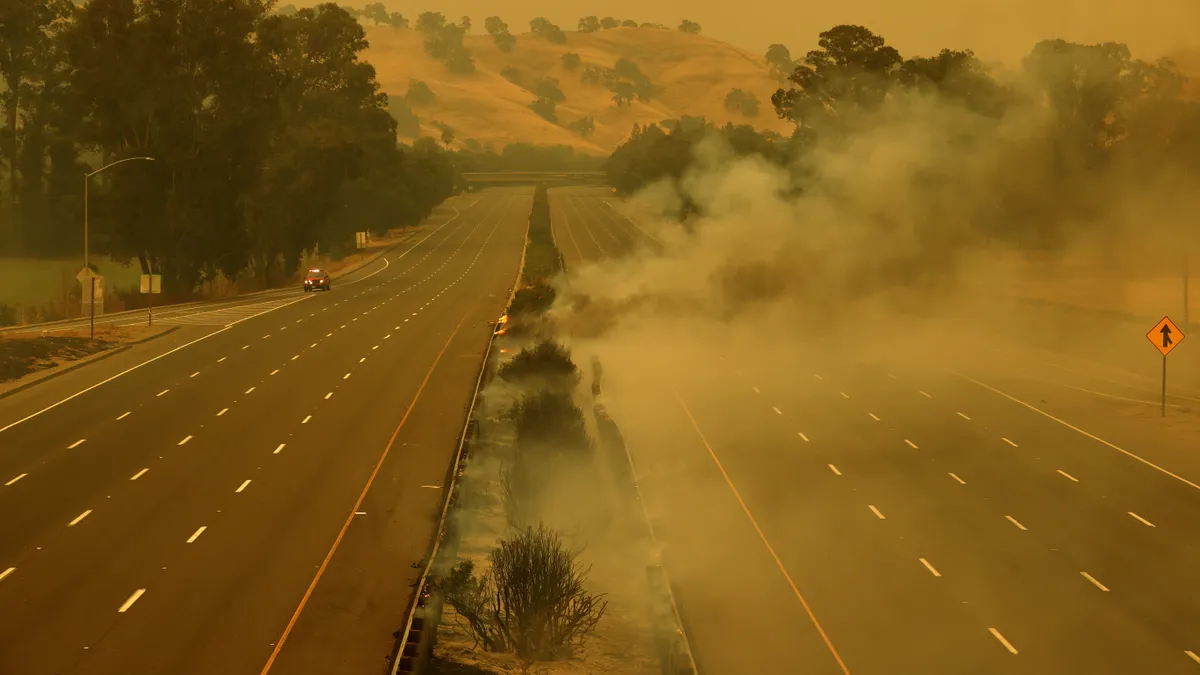Dive Brief:
- Pacific Gas & Electric (PG&E) believes it will probably incur a loss connected to the ongoing Dixie Fire, which began earlier this month and could be linked to the utility's power lines, the company reported in its 10-Q filing with the U.S. Securities and Exchange Commission on Thursday.
- The fire had burned over 221,000 acres in Northern California as of Thursday morning, with about 23% of it contained, according to state authorities. There's no way to estimate the total value of damage it has caused at this point, Patti Poppe, CEO of parent company PG&E Corp., said during the company's earnings call Thursday, but there has so far been limited harm to both structures and people.
- PG&E has adopted additional safety measures in light of the conditions this wildfire season, according to Poppe. "When we look at the tree density in our service area, and the proximity to our lines, we know we must do something different," she said.
Dive Insight:
PG&E notified regulators earlier this month that California fire officials have taken possession of its equipment, including portions of a 12 kV power line, as part of an investigation into the origins of the Dixie Fire. The news came just weeks after PG&E filed its 2023 general rate case application with the California Public Utilities Commission (CPUC), forecasting investments of $7.4 billion to reduce wildfire risks in its service territory from 2023 through 2026.
In addition, PG&E recently announced a sweeping initiative to bury around 10,000 miles of power lines — of the more than 25,000 miles of overhead lines it operates in high fire risk areas.
The Dixie Fire is being investigated by the California Department of Forestry and Fire Protection, as well as county district attorneys' offices, PG&E reported in its July 29 SEC filing. The company believes it is probable that it will incur a loss in connection with the fire, although it did not provide any estimates on the range of that loss, in part because those investigations are in very preliminary stages.
In 2019, California legislators created a $21 billion wildfire insurance fund to help utilities pay for fire-related damages. However, there will be a long process before PG&E could begin thinking about accessing that fund, PG&E Corp Executive Vice President and Chief Financial Officer Chris Foster said on Thursday's call. Cal Fire's investigation could take anywhere up to a year, followed by multiple years to complete, review and resolve any outstanding claims from the fire, he said.
PG&E Corp recorded $397 million in income available for common shareholders for the second quarter of 2021, or 18 cents per share, compared to a $1.9 billion loss in the second quarter of 2020, when the company was still in the midst of its bankruptcy reorganization process.
PG&E's plan to bury 10,000 miles of power lines could cost as much as $15 billion to $30 billion, NPR reported. The utility has traditionally been judicious about undergrounding power lines, taking up projects on a case by case basis in part because of high costs. However, the utility says it cracked the code on refining cost requirements for these projects, allowing it to bury more power lines, and sooner.
"This is not really a new idea or a new concept — many companies who have dealt with climate resilience issues like hurricanes, for example, have found ways to harden their system with a variety of methods, including undergrounding," Poppe said on the call.
The utility did not put an end date on the project, and is still working on that plan with its engineers, Poppe said, adding that the company decided to announce the plan before hammering out those details so that it could get the input of critical stakeholders and determine which areas to prioritize.
The effort is likely to be expensive, according to John Bartlett, president and portfolio manager at Reaves Asset Management. That said, undergrounding is a technique that has caught the imagination of consumers in California over the years, because it seems like a logical solution to preventing wildfires. He anticipates that there will be a back and forth over the plan at the CPUC, with a chance that the company will end up burying less power lines than its initial estimates, but all in all the effort "is a positive step forward for the company."
At the same time, Bartlett is skeptical that the scope of the project could significantly change the risk dynamic that wildfires pose to PG&E.
"I think the most important thing this would do, would probably be [that it is] really focused and directed in such a way that it lowers the risk of evacuations and interruptions and service outages, and stuff like that, in very targeted areas," he said.















